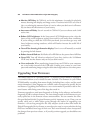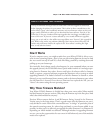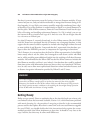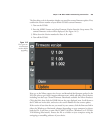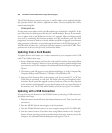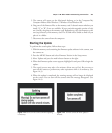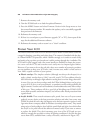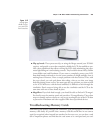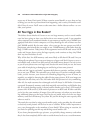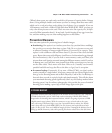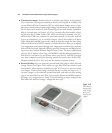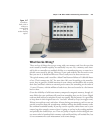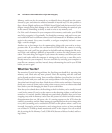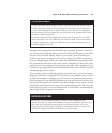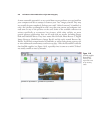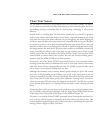access any of them. Don’t panic! If these scenarios sound horrific to you, there are lots
of things you can do to prevent them from happening, and a variety of remedies avail-
able if they do occur. You’ll want to take some time—before disaster strikes—to con-
sider your options.
All Your Eggs in One Basket?
The debate about whether it’s better to use one large memory card or several smaller
ones has been going on since even before there were memory cards. I can remember
when computer users wondered whether it was smarter to install a pair of 200MB (not
gigabyte) hard drives in their computer, or if they should go for one of those new-fan-
gled 500MB models. By the same token, a few years ago the user groups were full of
proponents who insisted that you ought to use 128MB memory cards rather than the
huge 512MB versions. Today, most of the arguments involve 8GB cards versus 16GB
cards, and I expect that as prices for larger capacity cards continue to drop, they’ll find
their way into the debate as well.
Why all the fuss? Are 8GB memory cards more likely to fail than 4GB cards? Are you
risking all your photos if you trust your images to a larger card? Isn’t it better to use sev-
eral smaller cards, so that if one fails you lose only half as many photos? Or, isn’t it wiser
to put all your photos onto one larger card, because the more cards you use, the better
your odds of misplacing or damaging one and losing at least some pictures?
In the end, the “eggs in one basket” argument boils down to statistics, and how you hap-
pen to use your D7000. The rationales can go both ways. If you have multiple smaller
cards, you do increase your chances of something happening to one of them, so,
arguably, you might be boosting the odds of losing some pictures. If all your images are
important, the fact that you’ve lost 100 rather than 200 pictures isn’t very comforting.
After all, the myth assumes that a damaged card will always be full before it becomes
corrupted. Fortunately, memory cards don’t magically wait until they are full before they
fail. In a typical shooting session, it doesn’t matter whether you’ve shot 3.5GB worth of
pictures on a 4GB card or 3.5GB worth of pictures on an 8GB card. If either card fails,
you’ve lost the same number of images. Your risk increases only when you start shoot-
ing additional photos on the larger card. In the real world, most of us who use larger
memory cards don’t fill them up very often. We just like having the extra capacity there
when we need it.
The myth also says that by using several smaller cards, you’re spreading the risk around
so that only some pictures will be lost in case of a failure. What is more important to
you, your photographs or the members of your family? When going on vacation, do
you insist on splitting your kin up and driving several smaller cars?
If you shoot photojournalist-type pictures, you probably change memory cards when
they’re less than completely full in order to avoid the need to do so at a crucial moment.
David Busch’s Nikon D7000 Guide to Digital SLR Photography470



